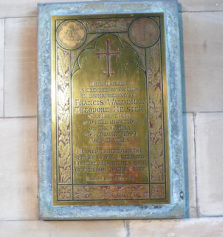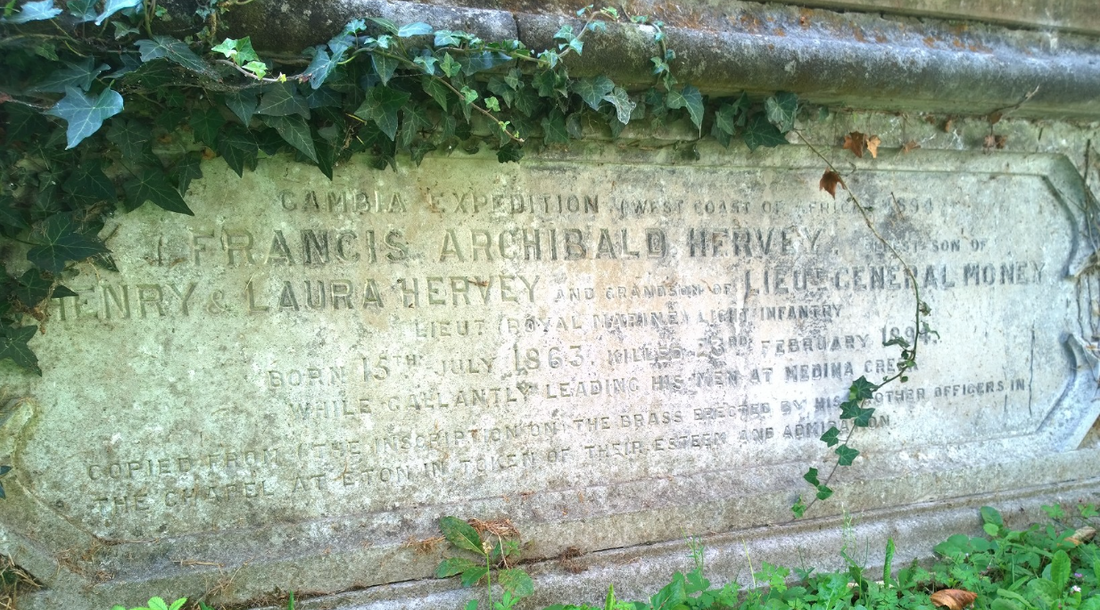FIGHT AGAINST SLAVERY, MADINA CREEK, GAMBIA, 1894
First-Lieutenant William Henry Arnold, HMS Raleigh
St. Bartholomew's, Great Barrow, Cheshire
Sub-Lieutenant Francis Waldemar Theodore Meister, HMS Magpie
Christ Church, Toxteth Park, Merseyside
Lieutenant Francis William Archibald Hervey, Royal Marines, HMS Raleigh
St. Andrew's, Trowse, Norfolk
The Background
Britain abolished slavery domestically in 1807, banned trading in the Empire in 1833, and for the remainder of the century was at the forefront of attempts to stop the slave trade. As its empire expanded it therefore came into direct conflict with established trading interests, and this conflict went on for much longer than one would think.
By the mid-19th Century the Atlantic slave trade had virtually disappeared, but that did not mean slavery had ceased. The market within Africa itself for slaves was still huge, and indeed grew as the plantation culture developed within the continent. Slave trading thus continued to be a very profitable occupation, and the leading Arab traders were very wealthy and powerful men. In The Gambia, on what was known at the time as The Slave Coast, one of those leading traders was a man called Foday Sillah (his name is spelt in various ways in different accounts; I have adopted the one found in a modern Gambian source). Some modern views portray him as a Muslim freedom fighter, fighting against unwanted colonial rule; a contemporary British view of him was that he had "always been a source of trouble, and [had] an unsavoury reputation in the Gambia District and on the Sierra Leone coast”. Whichever, he was a slave trader, and was not accepting British efforts to control his trade, building up a force of three thousand men, so in February 1894 a punitive expedition was launched against him.
The Action
Three ships (HMS Magpie, Raleigh and Widgeon) of the West Africa Squadron, under the command of Rear-Admiral Frederick Bedford, provided the majority of the men for the incursion. The force was split into two columns, with the aims of destroying a number of stockaded villages and capturing Foday Sillah’s main camp at Birkama, between Bathurst (modern Banjul) and the Cadimanze River. One column, commanded by Captain Edward Harpur Gamble of the Raleigh, consisted of two hundred and twenty-five bluejackets (naval personnel) from the three ships. The other, under the command of Lieutenant-Colonel A. D. Corbet of the Royal Marines, had fifty marines and fifty men of the West Indian Regiment. Both columns carried a small field gun.
Corbet’s group was to have a successful foray, destroying several villages and returning safely the next day. Gamble’s column, however, experienced problems. Initially all went well, and they destroyed two villages, but as they advanced they came under intense fire from enemy hidden in the thick bush. Slowed down by the sniping Gamble realised they were running out of water, and so he ordered a retreat back to one of the destroyed villages, where they spent the night without incident. The next day the force retreated further back to the riverbank, to be collected by the boats, only to find that the water was not yet high enough for the boats to come in. Then Foday Sillah’s men attacked, and Gamble’s men found themselves under fire from three sides, with the river preventing any further retreat, and with no cover available. As the attackers were concealed in the bush the gun was of little use, and the situation worsened when many of the native porters, who were carrying the ammunition, decided, understandably, to run away. By the time the boats could come in to rescue the survivors forty-six officers and men had been wounded (including Gamble), and a further eighteen killed, including First Lieutenant William Arnold of the Raleigh, Lieutenant Francis Hervey of the Raleigh’s Marines, and Sub-Lieutenant Francis Meister of the Magpie.
The Men
William Henry Arnold was a clergyman’s son, born in Stapleford in Hertfordshire in 1857. Although his paternal grandfather was a man of independent means in Little Missenden in Buckinghamshire, William Henry’s social status came from his mother, Charlotte, who was the daughter of the Marquess of Cholmondeley. William’s father, Edward, seems to have moved about the country working in various livings under the gift of his wife’s family, including Barrow in Cheshire, near one of the family seats, Cholmondeley Castle. Unlike many of the houses dealt with in these narratives, this is still in the family’s possession, as is the other major seat, Houghton Hall in Norfolk.
Francis Waldemar Theodore Meister, on the other hand, came from a mercantile family. His father, Richard, came to Liverpool in the 1860s from the Prussian port of Stettin, now Szeczecin in Poland, and established himself as a cotton merchant. He married a local girl, Fanny Banks, and they had five sons and two daughters. The ones I have traced went on to live respectable upper middle-class lives; one son became a bank inspector, two others public school masters, one at Windlesham in Surrey, the other at Sedbergh in what is now Cumbria.
Francis was only 21 when he died, at the start of his naval career. In contrast William Henry Arnold was well into his; as First Lieutenant his next promotion would probably have been to Commander, and the fulsome tributes paid to him on his death suggest that that would have happened. He had married a Miss Alice Burton Gray from Sydney , and they had a daughter in Australia before he was posted to West Africa. So many of the casualties covered in these stories are young single men that it is quite a shock to come across one who leaves behind a widow and a young child.
Francis William Archibald Hervey was a member of the aristocracy. His father was Henry Hervey, a member of the family of the Marquess of Bristol, , although the lineage is not crystal clear. Henry was born in 1831 in Madrid, and his father was William Hervey. However, the only William Hervey of that generation did not marry until 1844, and Henry does not feature in the official genealogy. Reasonable suppositions are that Henry was either illegitimate, but recognised by the family, or the offspring of an earlier, unrecorded, marriage (possibly in Spain?). He was certainly living with the Marquess' family as a child, and his probate named sons and grandsons of Lord William Hervey. He had a long career as a Foreign Office diplomat, and married Laura Money in 1862, with son Francis born a year later. Laura was of a military family, the daughter of Major-General Archibald Money and the granddaughter of Waterloo veteran Sir John Money. Sir John has some claim to fame as being one Britain's early aeronauts, making two balloon ascents in 1785.
Francis will not have had an easy childhood, despite his privileges. Laura died in 1871, and in the census of that year Francis and his brother, William, were at home in Chester Square, Knightsbridge, with their governess. His father remarried in 1880, and in 1884, a year after leaving Eton and matriculating at Corpus Christi, Cambridge, Francis left university to enrol in the Royal Marines, a decision that eventually led to his death on a West African beach. His brother, a wool buyer, died unmarried in 1936, and with him the direct line died out, although the Herveys are still the family of the Marquess of Bristol, including the current Marquess' celebrity socialite sisters, Lady Victoria and Lady Isabella.
Afterwards
Two postscripts to the story of the fight at Madina Creek: the bodies of Lieutenants Arnold and Hervey were recovered by the boats which rescued the survivors, but the other bodies, including that of Lieutenant Meister, were taken away by the slavers and never recovered; a few days after the defeat the British went in again, with larger numbers and a spirit of revenge, and drove Foday Sillah out of the region, into French-controlled territory further east, where he was captured and executed. His removal appears to have ended slavery in The Gambia.
IN MEMORY OF WILLIAM HENRY ARNOLD R.N. FIRST LIEUTENANT H.M.S. RALEIGH WHO WAS KILLED IN ACTION ON THE GAMBIA WEST COAST OF AFRICA FEBRUARY 23RD 18

THIS TABLET IS ERECTED BY FRIENDS IN LOVING MEMORY OF FRANCIS WALDEMAR THEODORE MEISTER SUB-LIEUT. R.N. WHO FELL IN ACTION ON THE GAMBIA 23 FEBRUARY 1894 AGED 21 YEARS. HE DIED FIGHTING IN THE SERVICE OF HIS QUEEN AND COUNTRY AND IN THE CAUSE OF FREEDOM TO THE SLAVE. ISAIAH CHAP. 58 VER. 6-8
(The Biblical quote reads: Is not this the fast that I have chosen? to loose the bands of wickedness, to undo the heavy burdens, and to let the oppressed go free, and that you break every yoke? Is it not to deal bread to the hungry, and that thou bring the poor that are cast out to thy house? When thou seest the naked, that thou cover him; and that thou hide not thyself from thy own flesh. Then shall thy light break forth as the morning, and thine health shall spring forth speedily; and thy righteousness shall go before thee; the Glory of the Lord shall be thy reward.)
(The Biblical quote reads: Is not this the fast that I have chosen? to loose the bands of wickedness, to undo the heavy burdens, and to let the oppressed go free, and that you break every yoke? Is it not to deal bread to the hungry, and that thou bring the poor that are cast out to thy house? When thou seest the naked, that thou cover him; and that thou hide not thyself from thy own flesh. Then shall thy light break forth as the morning, and thine health shall spring forth speedily; and thy righteousness shall go before thee; the Glory of the Lord shall be thy reward.)
Sources
Photos
Gambia Slavery - from www.accessgambia.com
Tablet to Francis Meister - Tinho Da Cruz, Christ Church, Toxteth Park, Liverpool
Tomb memorial to Francis Hervey - courtesy of Martin Kentish, with thanks to Mike Kelly
Military/genealogy
Online
en.wikipedia.org/wiki/HMS_Raleigh_(1873)
www.worldnavalships.com/forums/showthread.php?t=11071
www.nhcra-online.org/20c/german.html
http://paperspast.natlib.govt.nz/cgi-bin/paperspast?a=d&d=OW18940301.2.51
http://trove.nla.gov.au/ndp/del/article/13942404
http://trove.nla.gov.au/ndp/del/page/2938836
http://www.london-gazette.co.uk/issues/26509/pages/2603/page.pdfhttp://en.wikipedia.org/wiki/Slavery_in_Africa
http://www.accessgambia.com/information/ethnic-groups-relationship-slavery.htmlhttp://glosters.tripod.com/africa5.htm
www.ancestry.co.uk
© Jonathan Dewhirst 2013
Photos
Gambia Slavery - from www.accessgambia.com
Tablet to Francis Meister - Tinho Da Cruz, Christ Church, Toxteth Park, Liverpool
Tomb memorial to Francis Hervey - courtesy of Martin Kentish, with thanks to Mike Kelly
Military/genealogy
Online
en.wikipedia.org/wiki/HMS_Raleigh_(1873)
www.worldnavalships.com/forums/showthread.php?t=11071
www.nhcra-online.org/20c/german.html
http://paperspast.natlib.govt.nz/cgi-bin/paperspast?a=d&d=OW18940301.2.51
http://trove.nla.gov.au/ndp/del/article/13942404
http://trove.nla.gov.au/ndp/del/page/2938836
http://www.london-gazette.co.uk/issues/26509/pages/2603/page.pdfhttp://en.wikipedia.org/wiki/Slavery_in_Africa
http://www.accessgambia.com/information/ethnic-groups-relationship-slavery.htmlhttp://glosters.tripod.com/africa5.htm
www.ancestry.co.uk
© Jonathan Dewhirst 2013

